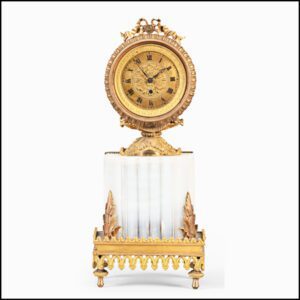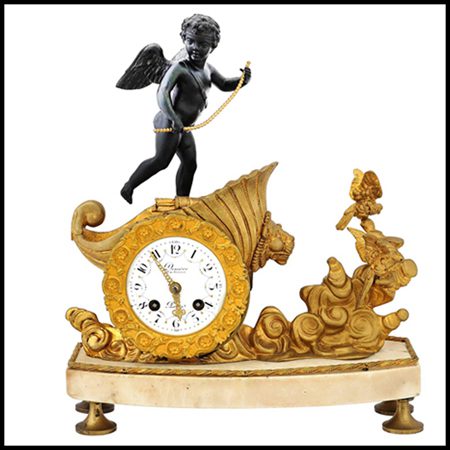The Beauty and Mystery of Rare Clocks
Few collectibles stir emotion like rare clocks. They are instruments of time, yet also instruments of wonder — crafted by hands that believed precision and poetry could coexist. Every tick carries history; every chime remembers the hours that once filled great rooms, salons, and studies.
To stand before rare clocks is to face time itself — disciplined, elegant, and enduring. They command attention not by noise, but by stillness. Collectors and admirers alike know that each clock tells more than time; it tells a story of invention, ambition, and survival.
From Craft to Culture
The artistry behind rare clocks defines eras. European makers in the 18th and 19th centuries elevated timekeeping into sculpture — designing cases of marble, ormolu, and glass that rivaled fine art. In that lineage, vintage French mantel clocks became the gold standard of refinement.
A vintage French mantel clock from a Paris workshop often featured porcelain dials, gilded bronze figures, and mechanisms that ran as smoothly as the court life they reflected. The chime of these vintage French mantel clocks was more than sound; it was social rhythm — the cadence of nobility marking its hours.
Collectors now pursue these vintage French mantel clocks as centerpieces of historical décor, drawn to their ornate presence and impeccable engineering. Few objects carry such harmony between mechanical precision and artistic indulgence.
The Character of Vintage Antique Clocks
If rare clocks represent the elite of horology, then vintage antique clocks represent its heart. They bring forward the warmth of domestic life, where timepieces served families across generations. From oak-cased longclocks to brass carriage pieces, vintage antique clocks tell the quieter story of everyday time — time spent living, working, and remembering.
Unlike the grand salon pieces, these vintage antique clocks often carry evidence of wear — slight imperfections that speak of repair and resilience. Their value lies not only in craftsmanship but in continuity. Each one is a witness to centuries of human rhythm, carrying the faint breath of the past into the present.
To collectors, rare clocks of this nature offer more than nostalgia. They offer participation — a way to preserve heritage through the simple act of winding.
The Daring Elegance of Vintage Art Deco Clocks
As the 20th century began to hum with machines and electricity, rare clocks evolved with it. The vintage art deco clocks of the 1920s and 1930s reimagined time as movement and design. Gone were the curls and cherubs of the Rococo age; in came chrome, glass, and geometry.
A vintage art deco clock symbolized speed and progress. With their mirrored faces, stepped bases, and bold numerals, these vintage art deco clocks captured the optimism of an era that believed tomorrow would always shine brighter.
Collectors now treasure vintage art deco clocks not only for their beauty but for their spirit — modern, fearless, and undeniably human. These rare clocks remain some of the most expressive artifacts of the early modern age, blending fashion and function in equal measure.
Why Rare Clocks Still Matter

In a world of digital everything, rare clocks remind us that time can be tangible — something you can hear, feel, and even smell in the faint oil of brass gears. They embody patience, because their care demands attention. To wind a clock is to take responsibility for time itself.
The collector’s affection for rare clocks runs deeper than investment. Each piece is a collaboration between inventor and caretaker. Owning one is not just possession; it’s stewardship. Every second that ticks through rare clocks continues the legacy of those who built them centuries ago.
For many, the appeal lies in contrast. Rare clocks don’t blink or buzz. They breathe. Their rhythm fills a room with life, marking not just hours — but meaning.
Preserving the Legacy of Rare Clocks
Preserving rare clocks requires a balance of science and sensitivity. Each mechanism must be cleaned, oiled, and adjusted with respect to the maker’s intent. Professional restorers work tirelessly to keep vintage antique clocks running true to their age, and to ensure vintage French mantel clocks continue to display their refined movements with grace.
Museums, workshops, and private collectors around the world contribute to the survival of these treasures. Even today, a newly restored vintage art deco clock may tick beside one built three hundred years earlier — proof that rare clocks connect generations through precision and passion.
Finding and Collecting Rare Clocks
The pursuit of rare clocks remains one of the most rewarding forms of collecting. Auctions in London, Paris, and New York feature everything from opulent vintage French mantel clocks to minimalist vintage art deco clocks. Smaller local dealers often surprise collectors with vintage antique clocks that still keep perfect time after centuries.
For anyone entering the field, the advice is simple: study, listen, and let the clock speak. The more you understand its sound and story, the deeper your appreciation grows. And when you find that one special piece — the rare clock that seems to echo your own sense of rhythm — you’ll know you’ve found not just an object, but a companion in time.
The Eternal Conversation of Time
In the silence between ticks, rare clocks tell the most profound story of all: that time can be art, and art can be eternal. Whether you’re drawn to the luxury of vintage French mantel clocks, the honesty of vintage antique clocks, or the sleek confidence of vintage art deco clocks, each holds a chapter of history that still beats in rhythm with your own life.
To live among rare clocks is to listen — quietly, reverently — as the past continues to move.


